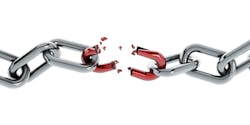NAHB Chairman's Message: NAHB Takes Action to Solve Supply Chain Issues
Excessive land development rules, burdensome federal regulations, and a shortage of skilled trade workers are among the challenges driving up the cost of producing a home. But the biggest obstacle throughout the pandemic has been breakdowns in the supply chain.
These supply chain failures are driving up the cost and delaying delivery of key building materials, including lumber, steel, plastic piping, copper wire, windows, doors, appliances, and many other needed inputs. Solving these supply chain challenges is the top priority for the National Association of Home Builders (NAHB).
Amid a time of extraordinary disorder in the global supply chain, NAHB is doing everything it can to deliver lasting solutions: the federal government affairs team is educating members of Congress about the extent of the problem and offering tangible solutions; our regulatory affairs and legal teams are seeking remedies through federal agencies and in the courts; our communications group is making sure the public and the press understand the depth of the problem; and our economics team is generating data that shows the tremendous costs of the supply chain failures and the potential benefits of proposed policy solutions.
RELATED
- 5 Supply-Chain Takeaways From the Pandemic
- Who Can Shorten the Supply Chain for Home Building
- The Supply Chain's Perfect Storm
According to the Bureau of Labor Statistics Producer Price Index, the average price of goods used as inputs in residential construction has risen more than 13% year to date—more than triple the rate of core inflation. Steel mill products, for example, climbed 5% in September, following a 5.1% increase in August. In the 14 months since July 2020, steel prices are up 134.1%.
Many of the products needed to build a home are stuck on cargo ships waiting at ports or are delayed further by shortages of truck drivers and factory and warehouse workers—the same issues causing many store shelves to appear bare. It’s a looming crisis, and the longer it takes products to arrive on a jobsite, the bigger the hit to a builder’s bottom line.
Tariffs and Transportation: Solutions for the Supply Chain
NAHB has been pushing Congress and the Biden administration to resolve supply chain issues by temporarily removing tariffs on lumber and other imported building materials, alleviating bottlenecks at seaports, and seeking solutions to persistent delays in truck and rail transportation.
To help members navigate the effects of these unprecedented breakdowns and supply challenges, NAHB has developed a new online resource, nahb.org/supplychain, which provides a broad range of strategies home builders and remodelers can employ, including escalation clauses in contracts, best practices in customer relations, tips for estimating in uncertain times, and material alternatives to lumber. It also explains some of the causes of the supply chain failures and outlines the steps NAHB has taken to help resolve the crisis.
Despite many challenges, new-home construction has been a bright spot for the economy throughout the pandemic and NAHB is working to make sure that remains the case. We will keep the pressure on policy makers and industry stakeholders to aggressively advance solutions that will repair the building material supply chain. We do this to support our members, to maintain our industry’s role as a vital engine of the economy, and to meet the housing needs of our nation’s families.

